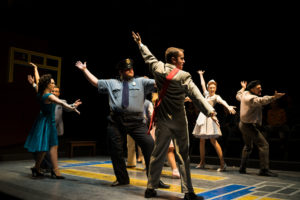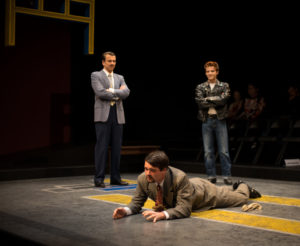By: Jacob Forbes, Staff Writer
Any theater that you attend most likely subscribes to a common practice: Simultaneously presenting new works and also re-setting older works to make sure they stand the test of contemporary relevance. Shakespeare, Brecht and Ibsen are still performed today and still enjoyed by many, partly because of contemporary acting companies and directors et. al. who are doing the difficult task of presenting dated plots and characters not as timeless, but timely.
The immediate problem with the Department of Theatre’s production of Tartuffe is that the re-imaging of the play into “the middle of the last century” fails at doing any sort of justice to the timely nature of Molière’s biting social commentary. In fact, the symbols of the 1950’s have been used, as they have often been used in the past, to becloud and detract from what is most ironic, complex or uncomfortable about the play.
Instead of 17th century middle-class Europeans, the USM production has produced stock 1950’s types for the stage. The whole play takes place in the home of a family, headed by the patriarch Orgon, played by Collin Young, who is a cross between an English gentleman and an American dad. There is a leather jacketed, rough-edged youth, straight out of 1978’s Grease, played by Aaron Verrill, named Damis and brother of Orgon. Orgon’s daughter Mariane, a central axis in the play’s plot, could also be right out of Grease as an innocent Sandy type. It is impossible to forget the other brother named Cleante, played by Dominic Fazio, who I suppose with his “hip” outfit and beret would be a beat poet. He even remembers to bring his bongos home in the first act to accompany his monologues. Last and certainly not least is the central antagonist Tartuffe, played by Drew Masse, who is outfitted to be a Southern-style preacher and sermonizes like a televangelist.

With all these character tropes in action, it is hard for viewer to even get into the play. So much is already being fogged-up by using these references to our American past. But reference is perhaps too kind of a word. What is most distressing is not just how silly or reductive these references are, but that they are not even close to the most relevant recontextualization that one could use. If you are going to try and reinterpret a 17th century French play for an audience in 2018, then do so with contemporary character types. The greaser, the pink-petticoated girl, the beat poet and the southern preacher are so overused as to be banal. Their use in this plot thus thwart any critical undertaking from the audience or the actor. Indeed, what we are left with is a room full of actors that are trying their best to be a vague caricature.
If you are about to interject about the important role of caricature in theater, especially comedic theater, then I would point out that the greaser and the southern preacher are not relevant or useful caricatures for 2018. They are caricatures being impersonated on stage by actors who have never met a beat poet, seen Elvis on live television, or known anything close to what life in the 1950’s could be called to be “like.” This is not to the actors’ detriment. They just grew up in whatever time was given to them. But to be twice removed from the material, first by the 17th century play then by the 1950’s “re-imaging” and then to attempting to interpret it is folly waiting to happen.

It is not just to the actor’s detriment when such tropes are used. Audience members are not even given the opportunity to probe characters when they are presented as pop culture “facts.” If one wants to honestly delve into a certain period of history it is important to be realistic about the complexity of an era, and not just settle for references to cinematic history. The various ideas or concepts that get presented through movies like Grease or even Hair present compelling, but ultimately reductive narratives and people.
A surprising result of the heavy use of dated character types was that the actors without so much built-in pop-cultural baggage, namely Mariah Larocque as Elmire, the wife of Orgon and Emily Grotz as Dorine the family maid, were able to carry the play with their performances. Ms. Larocque and Ms. Grotz were able to focus their efforts on the most important part of the play, the dialogue, and bring it to theatrical life with their ease of command over the rhyming couplets and their physical ease on stage.
With false piety amuck in our contemporary American culture – and I include the non-religious, liberal, conservative and the somnolent in this assessment – Moliére’s Tartuffe had great potential in the hands of a college theatre department. Unfortunately, the energy and honesty it requires to take a serious assessment of where we actually are now and not 60 years ago, did not come to fruition. The false beards on the false idols of our times will remain undisturbed in the realm of theater, for now.
